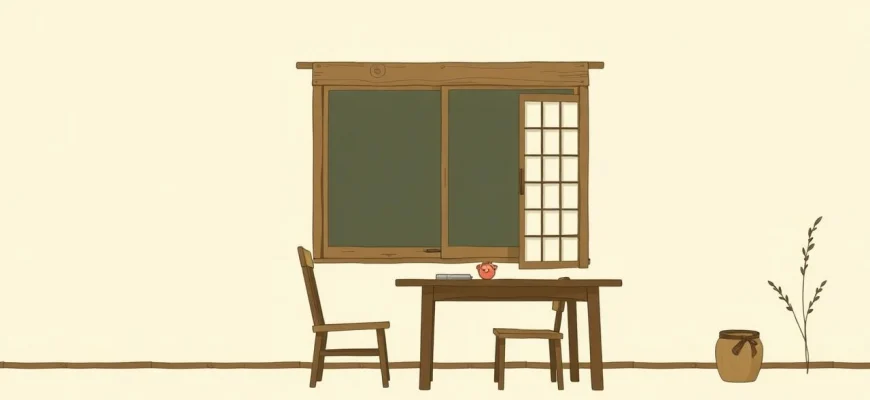If you were captivated by the emotional depth and subtle storytelling of 'Late Spring' (1949), you're likely searching for more films that evoke similar feelings of quiet introspection and familial bonds. This article explores 10 movies and shows that share the same delicate balance of drama, realism, and poignant beauty, perfect for fans of Yasujirō Ozu's masterpiece. Whether you're drawn to its meditative pacing or its exploration of tradition and change, these recommendations will resonate with your cinematic tastes.

A Story of Floating Weeds (1934)
Description: This early silent film by Ozu shows the director developing themes and visual styles that would mature in 'Late Spring'. The story of a traveling actor returning to his former lover and their son explores similar family dynamics.
Fact: This was Ozu's last completely silent film. Ozu would remake this film in color in
 Watch Now
Watch Now 
Early Summer (1951)
Description: Part of Ozu's 'Noriko Trilogy' along with 'Late Spring', 'Early Summer' continues the exploration of post-war Japanese family life and the pressures on women to marry. The film's gentle humor and poignant moments mirror the tone of 'Late Spring'.
Fact: The film's Japanese title, 'Bakushu', refers to the barley harvest season. Setsuko Hara, who plays Noriko in 'Late Spring', also stars in this film, though as a different character. Ozu's characteristic low-angle shots are prominently featured.
 Watch Now
Watch Now 
Tokyo Story (1953)
Description: Directed by Yasujirō Ozu, 'Tokyo Story' shares the same director as 'Late Spring' and explores similar themes of family dynamics, generational conflict, and the passage of time. Both films are part of Ozu's 'Noriko Trilogy' and feature his signature static camera shots and minimalist storytelling.
Fact: 'Tokyo Story' is often considered one of the greatest films ever made. The film was inspired by Leo McCarey's 'Make Way for Tomorrow' (1937). Ozu's use of 'pillow shots'—transitional shots of empty spaces—is prominent in this film.
 Watch Now
Watch Now 
Ugetsu (1953)
Description: While more supernatural than 'Late Spring', Kenji Mizoguchi's 'Ugetsu' shares a similar contemplative pace and explores themes of family separation and regret. Both films are considered masterpieces of Japanese cinema.
Fact: Won the Silver Lion at the Venice Film Festival. Based on stories by Ueda Akinari and Guy de Maupassant. Features one of cinema's most famous ghost scenes.
 Watch Now
Watch Now 
Sansho the Bailiff (1954)
Description: Another Mizoguchi masterpiece, 'Sansho the Bailiff' shares with 'Late Spring' a profound humanism and focus on family bonds, though in a much more tragic historical context. Both films feature stunning cinematography.
Fact: Based on a medieval Japanese folk tale. The film's famous parting scene is one of the most emotional in cinema history. Won the Silver Lion at Venice, continuing Japan's post-war cinematic renaissance.
 Watch Now
Watch Now 
Equinox Flower (1958)
Description: Ozu's first color film, 'Equinox Flower' deals with similar generational conflicts as 'Late Spring', particularly around marriage traditions. The film's warm palette and domestic setting create a similar intimate atmosphere.
Fact: This was Ozu's first film to be shot in color. The title refers to the red spider lily, which blooms around the autumn equinox. The film marks a shift in Ozu's work to more contemporary post-war Japan settings.
 Watch Now
Watch Now 
The Ballad of Narayama (1958)
Description: Keisuke Kinoshita's film, like 'Late Spring', deals with family obligations and the passing of generations, though in a more extreme, allegorical context. Both films reflect on Japanese cultural traditions.
Fact: The film is based on a novel by Shichiro Fukazawa. Uses kabuki-style staging and lighting. Was remade in 1983 by Shohei Imamura, winning the Palme d'Or at Cannes.
 Watch Now
Watch Now 
Good Morning (1959)
Description: While more comedic than 'Late Spring', 'Good Morning' shares Ozu's trademark style of observing everyday family life. The film's focus on communication (or lack thereof) within families connects it thematically to 'Late Spring'.
Fact: The film is a loose remake of Ozu's 1932 silent film 'I Was Born, But...'. It features one of cinema's most famous fart jokes. The children's obsession with television reflects Japan's rapidly modernizing society.
 Watch Now
Watch Now 
Floating Weeds (1959)
Description: Directed by Yasujirō Ozu, 'Floating Weeds' shares the director's signature style of slow, deliberate pacing and focus on human relationships. While it deals with a traveling theater troupe, its emotional depth and visual composition are reminiscent of 'Late Spring'.
Fact: This film is a remake of Ozu's own 1934 silent film 'A Story of Floating Weeds'. The film was shot in vibrant color, unlike many of Ozu's earlier works. It features a rare (for Ozu) musical score by Toshiro Mayuzumi.
 Watch Now
Watch Now 
An Autumn Afternoon (1962)
Description: Another masterpiece by Yasujirō Ozu, 'An Autumn Afternoon' revisits the theme of a father dealing with his daughter's marriage, much like 'Late Spring'. The film's contemplative tone, focus on everyday life, and visual style are quintessentially Ozu.
Fact: This was Ozu's final film before his death in 196The film's original Japanese title, 'Sanma no aji', translates to 'The Taste of Mackerel'. It features Ozu's frequent collaborator, actor Chishū Ryū, in the lead role.
 Watch Now
Watch Now 








